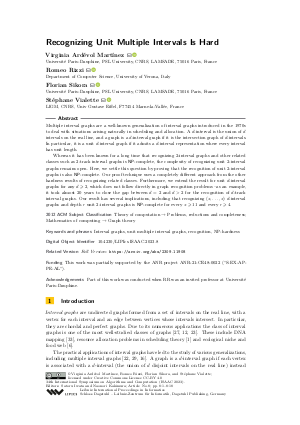@InProceedings{ardevolmartinez_et_al:LIPIcs.ISAAC.2023.8,
author = {Ard\'{e}vol Mart{\'\i}nez, Virginia and Rizzi, Romeo and Sikora, Florian and Vialette, St\'{e}phane},
title = {{Recognizing Unit Multiple Intervals Is Hard}},
booktitle = {34th International Symposium on Algorithms and Computation (ISAAC 2023)},
pages = {8:1--8:18},
series = {Leibniz International Proceedings in Informatics (LIPIcs)},
ISBN = {978-3-95977-289-1},
ISSN = {1868-8969},
year = {2023},
volume = {283},
editor = {Iwata, Satoru and Kakimura, Naonori},
publisher = {Schloss Dagstuhl -- Leibniz-Zentrum f{\"u}r Informatik},
address = {Dagstuhl, Germany},
URL = {https://drops.dagstuhl.de/entities/document/10.4230/LIPIcs.ISAAC.2023.8},
URN = {urn:nbn:de:0030-drops-193102},
doi = {10.4230/LIPIcs.ISAAC.2023.8},
annote = {Keywords: Interval graphs, unit multiple interval graphs, recognition, NP-hardness}
}

 Creative Commons Attribution 4.0 International license
Creative Commons Attribution 4.0 International license












